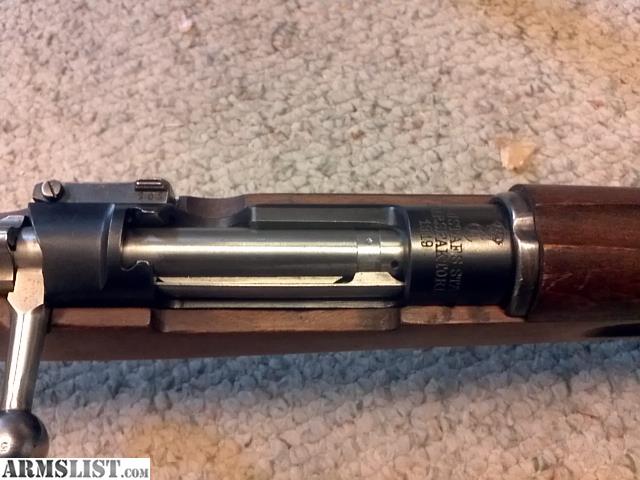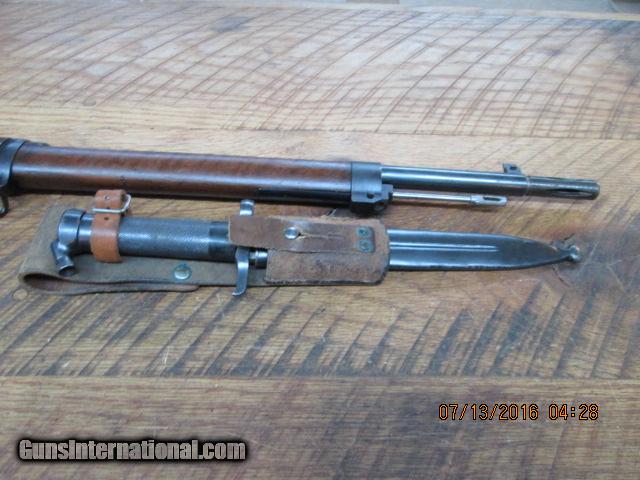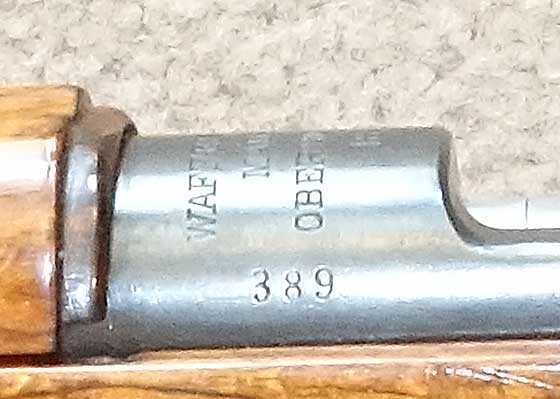- M96 Swedish Mauser Serial Numbers Chart
- Swedish Mauser Identification
- M96 Swedish Mauser Serial Numbers For Sale
| FAQ about Swedish Mausers. |
M96 Swedish Mauser Serial Numbers Chart
up dated 2009-10-17
| Q: What was the muzzle thread used for? |
A: It was used to attach the blank firing device. It is normally found on m/1938 and rarely on m/1896. It is never found on the sniper-version m/1941 or the carbine m/1894. |
| Q: I have seen a bag on the side on pictures? |
A: The bag was used only for peace time exercises to collect spent brass after firing of blanks. |
Apr 09, 2008 Swedish Mauser M96 Serial Number 379 If this is. The 3 digit serial number could be a CG 1898 rifle (serial number 1 to 32xx) or Mauser 1900 rifle (serial number 1 to 5000) rifle serial number. At some point in time the receiver did not pass inspection, so it had to be replaced.
- M96 Swedish Mauser Serial Numbers Vore Games Play Best Cars For Tall Drivers Download Kuroshitsuji Season 2 Sub Indo Mp4 Def Jam Fight For Ny Pc Download Full Version. If you can find a Swedish Mauser with matching numbers, that will be better in the long run. Even if you have to pay a.
- Without having access to the manufacturing records of Carl Gustav, this would be difficult to determine based on serial number, and even more so without knowing the exact model of the rifle.
- Here is another 'all correct' example of an 1899 M96/38 Swedish Short Rifle Serial # 23669, also converted by Carl Gustafs Stads Gevarsfaktori between 1938-1940. This particular rifle is unique in that it was originally mfg in Germany uncer license as an M96 rifle by Waffenfabrik Mauser, Oberndorf a/N in 1899.
- Markings on Swedish mauser rifles. Text Mats Persson. How to read the markings on the Swedish m/94 Carbine and on the m/96 and m/38 Rifles. Manufacturing The name of the manufacturer and the year of manufacture are on the top of the receiver. The serial number is on the left side of the receiver.
Swedish Mauser Identification
[Top of the page]
| Brass disk information. | |
The disks are positioned upside down on the right side of the stock, because when the soldier who normally is a right-handed shooter, looks at the disk he will have the disk in the right position. | |
Upside down is a disk from a g m/38; | Here we look at a disk from a Ag m/42B; |

| Swedish | English |
| Torped | Bullet with boat tail (also means 'torpedo') |
| Överslag | 'Point of impact over line of sight' (also means 'estimate') |
| STR = Streck | Mills (1 Swedish mill = 1 meter at 1000 meters = 3,6' at 100 yds) |
| The largest sector is stamped with the calibre of the barrel. The m/41 round had a much flatter trajectory than the older m/94. As most rifles were already manufactured with iron sights for the 'm/94 bullet', the aiming correction in mills (how much lower you had to aim to hit the target) was inscribed on the brass disc. This is the information in the second sector. It was usually 0,5 mill. The last sector gives information on the level of bore pitting. 1 means pitting in the groves. 2 means pitting in the groves and on the side of the lands. 3 means pitting in the whole bore (= unserviceable). A rifle would never receive a 3, it would instead be turned in to a work shop, where the old barrel would be exchanged for a new one. | |
| Brass disk with two wholes (courtesy of Mats Persson) | ||||||||||||||||||||||||||||||||||||||||||||||||||||||||||||||||||||||||||||||||||||||||||||||||||||||||||||||||||||||||||||||
Used on the m/94 carbine, the m/96 and m/38 rifles as well as on LMGs and SMGs. This type showed which unit the rifle belonged to. ArmyOften in the form of:
Sometimes there is a letter behind the regiment. Other army units;
There could be a letter instead of a figure above the horizontal line
The disc could also look like: L Which means; Rifle number 5, at the 72nd Landstormen area, Or: Which means; Rifle number 20, at the bicycle-dispatch unit Some later codes or abbreviations for regiments or other army-units,
Even later also:
Some weapons stored in the Armys Supply Services Armourys
NavyThe Swedish Navy often used;
The Navy used to be organized in four districts;
The Coast Artillery (that was a part of the Navy) sometimes used;
(HK was later changed to NK and KA4H was changed to KA5) It seems like the Coast Artillery also used the KA1 - KA5 denotations. The Navy also used numerous other markings, like:
Air ForceThe Swedish Air Force used;
|
[Top of the page]
M96 Swedish Mauser Serial Numbers For Sale

| Was there a special sniper rifle version of the m/96? Yes, there was a special sniper rifle version of the m/96 designated rifle m/41 ('Gevär m/41'). These rifles were selected species of 'well shooting' m/96’s. Prior to the modifications their bores were checked and the rifles were fired for accuracy. The modifications consisted of drilling and tapping the receiver on the left side of the receiver and to mount a telescopic sight with mount. These sniper rifles are now obsolete, and were replaced in 1991 with the modern 7,62 mm sniper rifle PSG 90. This rifle had a a two whole brass disk, which reads: 'G m/41 B' |
| What does the 'turn down bolt handle' indicate? |
| A 'turn down bolt handle' on m/1938 rifles indicates that the rifle is a converted m/1896. All m/96 had straight bolt handles. Husqvarna made m/1938 were normally produced as m/38 with the handle down from the beginning (like the picture above). However there is a small number of HVA produced m/1896 (with straight handles). |
| Q: Why is there a lug on the cooking piece? |
| The soldiers were allowed to dry fire the rifles in training if they first put a piece of leather between the cooking piece and the bolt. That was the reason for the lug on the cooking piece. On the picture the mechanism is cocked and locked. Safe to the same side as the handle! The reason for the checkering of the cooking piece is to make it easier to dismantle the bolt. |
[Top of the page]
| Q: What accessories were used? | |
The following accessories have been used over the years:
| |
| Illuminating night sights | |
Front sight adjustment vise | |
Different front sight adjustment vises were used. On top m/43G marked with instructions for adjusting the sight of the m/96 and m/38. To the left another type of adjustment vise. | |
[Top of the page]
| Q: Why is the cleaning rod so short? | |
| There was an attachment that should have been used, but it was never issued for the field service - only for peace time cleaning in the barracks. It looked like this. | |
This Muzzle protection was normally used together with the cleaning rod. | |
Q: What was the purpose of the hole in the front barrel band? |
| It was used during rests when the soldiers connected their rifles together with a cleaning rod through this hole. |

Bolt handles on Kar m/94, Rifle m/96 and m/38. | |
| Mechanism of Carbine m/94 | |
| Mechanism of Short rifle m/38 type 2 | |
| Mechanism of Long rifle m/96 and Short rifle m/38 type 1 | |
| Mechanism of Long rifle m/96 | |
Production figures for the Swedish Army Rifles
m/1896, m/1938, m/1941 and Carbine m/1894.
| Weapon | Manufacturer | Production | Quantity |
| Carbine m/94 ('Karbin m/94') | Mauser | 1894-1896 | 12.000 |
| Carbine m/94 ('Karbin m/94') | Carl Gustafs Stads Gevärsfaktori | 1895-1933 | 115.000 |
| Rifle m/96 ('Gevär m/96') | Mauser | 1896-1899 | 40.000 |
| Rifle m/96 ('Gevär m/96') | Carl Gustafs Stads Gevärsfaktori | 1899-1936 | 475.000 |
| Rifle m/96 ('Gevär m/96') | Husqvarna Vapenfabriks AB (HVA) | 1942-1944 | 20.000 |
| Rifle m/38 ('Gevär m/38') | Carl Gustafs Stads Gevärsfaktori | 1938-1940 | 55.080 m/96 were converted to m/38 |
| Rifle m/38 ('Gevär m/38') | Husqvarna Vapenfabriks AB (HVA) | 1942-1944 | 88.150 |
| Sniper rifle m/41 ('Gevär m/41') | Carl Gustafs Stads Gevärsfaktori | 1941-1943 | 5.300 selected and modified m/96 |
Husqvarna Vapenfabrik AB
Serial Numbers/year

| Rifle m/38 (Gev m/38) | Low | High | Quantity |
| 1941 | 600035 | 628717 | 28 672 |
| 1942 | 628822 | 667603 | 38 781 |
| 1943 | 669783 | 683939 | 14 156 |
| 1944 | 704000 | 705969 | 1 969 |
| Rifle m/96 (Gev m/96) | Low | High | Quantity |
| 1942 | 695810 | ||
| 1943 | 689087 | 697837 | 8 750 |
| 1944 | 697641 | 702969 | 5 328 |
| 1945 | 698649 |
[Top of the page]
